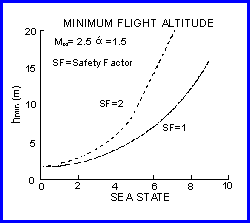Nielsen Engineering & Research (NEAR) has pioneered the development of a computationally efficient multidisciplinary flight simulation program applicable but not limited to sea skimming missiles as shown in the sketch. The comprehensive methodology includes detailed modeling of the unsteady aerodynamics, the control system and sensors, and the flexible structure characteristics.  A unique feature is the use of indicial theory to model the unsteady aerodynamic response of all the vehicle modes: rigid, flexible, and control. The developed technology can be used to design improved sea skimming missiles and control systems, for flight simulations of highly maneuverable aircraft, and for other systems where time dependent system states can be modeled efficiently with indicial functions. The following paragraphs provide a brief description of the innovative technology developed.
A unique feature is the use of indicial theory to model the unsteady aerodynamic response of all the vehicle modes: rigid, flexible, and control. The developed technology can be used to design improved sea skimming missiles and control systems, for flight simulations of highly maneuverable aircraft, and for other systems where time dependent system states can be modeled efficiently with indicial functions. The following paragraphs provide a brief description of the innovative technology developed.
The unsteady aerodynamic characteristics of the vehicle are determined from generalized indicial functions (GIFs) of the aerodynamic loads, i.e., the responses of the vehicle to step inputs in the aeroservoelastic modes. A significant advantage of this approach is that the aerodynamic response (including aerodynamic phase lags) to complex unsteady stimuli, such as deformations associated with multiple aeroelastic modes, may be predicted solely from the knowledge of the indicial functions which only require one calculation per modal deformation about a given mean configuration. These multiple aerodynamic modes may occur in a wide range of frequencies which may be excited as a consequence of rapid maneuver, or gusts, or by control inputs to various actuators. Therefore, the indicial function approach represents a considerable reduction in unsteady aerodynamics computational requirements in view of the very large number of parameters involved in a simulation.
 A CFD program, TSDVRT, is used to calculate the unsteady GIFs for all of the vehicle modes. These GIFs are computed outside the simulation program, and only need to be computed once to characterize the unsteady aerodynamics for a given flight Mach number. Within the simulation, a Duhamel convolution integral is employed to compute the generalized aerodynamic forces (GAFs) from the GIFs. To further increase the computational efficiency of the simulation, the GIFs are curve fit with exponentials/trigonometric functions. The benefit of the curve fitting is that the convolution integral for each GAF is reduced to an ordinary differential equation which can be integrated with the rigid, flexible, and control system state equations. The structure of the simulation developed, with the augmented differential equations representing the unsteady aerodynamics, lends itself to implementation on a parallel architecture computer. Calculated results, as a function of sea state, of the minimum altitude required for a supersonic sea skimming missile to avoid wave clobber are predicted in the sketch.
A CFD program, TSDVRT, is used to calculate the unsteady GIFs for all of the vehicle modes. These GIFs are computed outside the simulation program, and only need to be computed once to characterize the unsteady aerodynamics for a given flight Mach number. Within the simulation, a Duhamel convolution integral is employed to compute the generalized aerodynamic forces (GAFs) from the GIFs. To further increase the computational efficiency of the simulation, the GIFs are curve fit with exponentials/trigonometric functions. The benefit of the curve fitting is that the convolution integral for each GAF is reduced to an ordinary differential equation which can be integrated with the rigid, flexible, and control system state equations. The structure of the simulation developed, with the augmented differential equations representing the unsteady aerodynamics, lends itself to implementation on a parallel architecture computer. Calculated results, as a function of sea state, of the minimum altitude required for a supersonic sea skimming missile to avoid wave clobber are predicted in the sketch.
Commercial Applications: NEAR has used this technology for the analysis of two Navy sea skimming missiles and plans to commercialize the technology developed. Many applications for the technology have been identified, including
- further development of the current simulation to design high speed sea skimming missiles and control systems,
- application to flight simulations of highly maneuverable aircraft,
- use of parallel computers for development of real-time flight simulators including accurate unsteady aerodynamics, and
- application to other systems where time dependent system states can be efficiently modeled with indicial functions.
Reference:
Unsteady Simulation of Flexible Missiles Flying Low Over the Sea
Daniel J. Lesieutre, Patrick H. Reisenthel, Marnix F. E. Dillenius, Danilo Viazzo, Steve Fisher, Sudarshan Bhat, and Samuel C. McIntosh
[available as AIAA paper 94-0720]
Copyright © 1994 Nielsen Engineering & Research
ABSTRACT: A detailed investigation into the factors affecting transonic missile flight low over the sea has been performed. The simulation program developed in this effort models a flexible missile flying low over the sea and includes unsteady aerodynamics and detailed models of the control system, sensors, and structure. Unsteady aerodynamics are included in the simulation through the implementation of indicial theory. An extended six-degree-of-freedom model has been developed which includes control fin deflections and body elastic modes as additional system states. A sea wave/wind gust model has been developed which acts as an unsteady forcing function on the missile during its flight. The states of the system (6-DOF, fin deflections, and flexible body modes) are coupled and integrated in the simulation. Unsteady aerodynamics can affect the performance of the missile directly or by excitation of the flexible body modes which can cause accelerations and spurious inputs at sensor locations.
MDO Configuration Optimization
Payload Fairing Shape Optimization
Multidisciplinary Flight Simulation
Multidimensional Data Analysis and Risk Assesment





